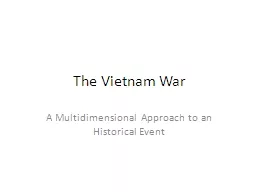

Importance Learning about the war in Vietnam is important because It was a war that the US joined without public support It was the last time that a draft was used in the US and Australia It was the first war in which mass communication had immediate ramifications on the various ID: 783088
Download The PPT/PDF document "The Vietnam War A Multidimensional Appro..." is the property of its rightful owner. Permission is granted to download and print the materials on this web site for personal, non-commercial use only, and to display it on your personal computer provided you do not modify the materials and that you retain all copyright notices contained in the materials. By downloading content from our website, you accept the terms of this agreement.
Slide1
The Vietnam War
A Multidimensional Approach to an Historical Event
Slide2Importance
Learning about the war in Vietnam is important because:
It was a war that the US joined without public support.
It was the last time that a draft was used in the US and Australia.
It was the first war in which “mass communication” had immediate ramifications on the various “
homefronts
”. This includes propaganda, video footage, and journalists in the field.
Slide3Global Relevance
Countries involved in Vietnam were: South and North Vietnam, New Zealand, Australia, Thailand, Khmer Republic, Laos, North Korea, China/Taiwan, Cambodia, Soviet Union, Philippines, Cuba, France, and the United States. Each of these countries had a different role in the war, but soldiers from every country/region gave their lives.
Slide4Foundational Knowledge
Students will first need to understand (via lecture, reading from text, and other materials):
Communism/anti-communism
The region of North and South Vietnam
Dates and locations of major events (example: My Lai massacre in March of 1968).
Varying home-front responses.
Slide5AOK: Aesthetics
Slide6Adams, Eddie.
Saigon Execution.
1968. Saigon.
Barbaric Poetries: Vietnam War Photography.
Web. 24. Oct. 2013.
Photography coming out of Vietnam was violent, stark. This photograph was a Pulitzer Prize winner in 1968. The power of it rests in the eyes of the bound Vietnamese man staring straight ahead as a gun barrel hangs centimeters from his face. “Saigon Execution” is one of the most recognizable photographs in military history, and it played a contributing role in turning public opinion against the Vietnam War. The image—by combat photographer Eddie Adams—captures the moment a uniformed South Vietnamese officer fires a bullet into the head of a man who appears to be a civilian.
Taken out of context, the photo seems to evince a senseless act of brutality, which explains why it was later used in support of the moral argument that protestors made against the war. But the reality is that the shooter (General Nguyen Ngoc Loan), was executing a ruthless Viet Cong assassin (Nguyen Van
Lem
, aka Bay Lop), who was leading a team that had targeted the general himself
. I would show students the photo and ask them to write a story behind it (assuming they’ve had no exposure to it). Then I would share with them the “true” story and ask them how the media impression vs. the real story can have an affect on the viewer.
Slide7Questions
While the two main subjects of this photograph are Vietnamese, the photographer is American. What is the responsibility of someone capturing images like this one who is from another culture entirely?
(discussion question)
How can art contribute to the formation of pubic opinion during war or times of conflict?
(knowledge issue)
Slide8AoK: Human Sciences
Blue Three Media, , dir.
"Now, After"
. YouTube, 2007. Film. 27 Oct 2013. <http://
www.youtube.com
/
watch?v
=NkWwZ9ZtPEI>.
This
mini-documentary
entitled “Now, After” was created by a soldier who fought in Iraq, then went to film school after he returned in order to document his struggles with PTSD. This very real psychological ramification of war is not something that was given much attention during the 1960s and 1970s. Many soldiers who came back from Vietnam were never treated for PTSD and have been suffering since then.
As the US and other countries continue to join wars, soldiers are treated upon their return for physical and also mental wounds. One commonality among any soldier who fights in any conflict is that taking the lives of other human beings has psychological ramifications. While this is a terrible way to connect human-to-human, it is connection nonetheless.
I would show this to students and ask them to discuss in small groups if they agree or disagree with the idea of PTSD counting as a war “wound” and how this trauma can be avoided or treated in returning soldiers. I would then have
the small groups report out to the class.
*Graphic images in documentary!
Slide9Questions
We know that “casualties of war” generally refers to a death count. Is there validity to loss—psychologically speaking—being another casualty of war? Do politics take this into consideration when joining conflict, in your opinion? Should it be a consideration
? (knowledge issue)